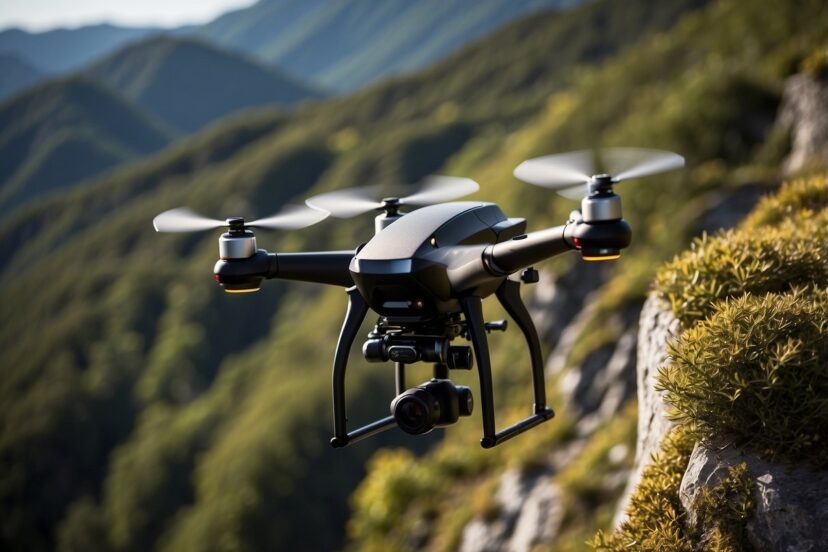Benefits of Drone Videography for Aerial Footage
*We may earn a commission for purchases made using our links. Please see our disclosure to learn more.
Benefits of Drone Videography: Enhancing Visual Storytelling and Efficiency
Drone videography has changed the way we capture the world around us. As someone who’s been working with drones for years, I’ve seen firsthand how they offer stunning, high-quality footage that’s unmatched by conventional cameras. One of the benefits of drone videography is its cost-effectiveness compared to traditional aerial filming methods.
Using drones, I can capture unique and breathtaking perspectives that were once inaccessible or extremely expensive to achieve. From flyovers of vast landscapes to dynamic shots of events, drones make it possible to get close to the action without being intrusive. Their ability to shoot full HD and up to 5K video resolution ensures that every detail is crisp and clear.
Drone technology allows operators to film in ways that were previously unimaginable. With their ability to fly lower than helicopters and get closer to the action than traditional cameras, drones open up a world of creative possibilities. Whether for business promotions, special events, or personal projects, drone videography provides a fresh, dynamic view that stands out.
Enhanced Visual Appeal

Drone videography offers incredible opportunities to capture unique, eye-catching visuals. By utilizing creative angles, seamless panoramic views, and dynamic movements, drones help filmmakers and businesses tell compelling stories.
Creative Angles and Perspectives
Drones allow me to achieve angles that were previously impossible or difficult to capture. From high-altitude shots looking down to low shots weaving through tight spaces, the creative possibilities are vast.
With a drone, I can capture stunning bird’s-eye views or unique side angles, enhancing any project’s visual storytelling. By exploring varied perspectives, I can add visual interest and depth, making the footage stand out.
Using drones also means I can shoot from different heights without needing cranes or helicopters. This flexibility is invaluable when striving to get the perfect shot.
Benefits of Drone Videography: Seamless Panoramic Views
One of the greatest advantages of drone videography is the ability to capture seamless panoramic views. Drones equipped with high-quality cameras and stabilization technology make it easy to shoot wide, sweeping vistas with minimal effort.
Panoramic shots are perfect for landscape videos, real estate marketing, and showcasing large events. When I record these views, it provides a comprehensive look at the environment, adding a sense of scale and grandeur to the footage.
Additionally, the ability of drones to hover in place ensures that panoramic images and videos are smooth and free of jitter, enhancing the overall quality of the visual content.
Dynamic Movement and Storytelling
Dynamic movement is crucial for engaging video content. Drones excel at capturing smooth, flowing motion that adds energy and excitement to any project. Whether it’s tracking a car chase, following a person through a forest, or circling around a building, the dynamic shots created by drones can transform the narrative.
By integrating these movements, I can guide the viewer’s eye and direct their attention effectively. This dynamic storytelling is essential for action scenes, travel videos, and any scenario where movement enhances the story.
The versatility in movement, combined with advanced stabilization, ensures that each shot is steady and visually appealing, making drone videography an indispensable tool for modern visual storytelling.
Benefits of Drone Videography: Operational Advantages

Drone videography offers several operational advantages. These include reaching remote areas, saving on costs, and reducing the time needed for various tasks.
Access to Remote Locations
Drones can easily access remote or hard-to-reach locations. Whether it’s rugged terrain, dense forests, or tall buildings, drones can fly over and provide high-quality visuals.
I find this particularly useful for tasks like inspecting infrastructure, such as bridges or power lines, where sending human inspectors can be dangerous and time-consuming. Environmental monitoring also benefits, as drones can cover large areas quickly without disturbing the ecosystem.
Cost Efficiency
Employing drones for videography significantly cuts down expenses. Traditional aerial methods like helicopters are costly due to fuel, maintenance, and crew.
Drones eliminate many of these costs. I appreciate how this technology democratizes aerial videography, making it accessible even for smaller businesses.
Time Savings
Drones save considerable time in various operational tasks. Setting up and deploying a drone is quick compared to traditional methods.
For example, during events, drones can be in the air capturing footage within minutes. This rapid deployment and flexibility make them invaluable.
Benefits of Drone Videography: Marketing Benefits

Drone videography can transform your marketing strategy by providing unique visual content that captures attention and promotes higher engagement. Let’s look into how this works specifically.
Increased Engagement
Using drone videography, I can create captivating visuals that are difficult to achieve with traditional methods. High-quality aerial shots and dynamic movement keep the audience interested.
When I include drone footage in my marketing campaigns, my audience is more likely to watch and share the content. This leads to better engagement metrics like views, shares, and likes.
Drones allow me to showcase products and events from unique angles that were previously impossible, making my promotional content stand out. This visual appeal not only attracts more attention but also helps in conveying messages more effectively.
Benefits of Drone Videography: Technical Superiority

Drone videography offers impressive technical advancements that enhance video production. These advancements include high-resolution output and real-time feedback capabilities.
High-Resolution Output
One of the standout features of drone videography is its ability to capture high-quality video. Modern drones can shoot in full HD, 4K, and even up to 5K resolution. This high-resolution output ensures that the footage is sharp and detailed, which is critical for professional video projects.
Drones also come equipped with advanced camera sensors and image processing technology. These features ensure the captured footage maintains high color accuracy and dynamic range. Additionally, the use of a gimbal with three-axis stabilization helps keep the video smooth, even during complex aerial maneuvers.
Real-Time Feedback
Real-time feedback is another significant advantage of drone videography. Many drones offer live video feed capabilities, allowing the operator to see exactly what the drone is capturing in real-time. This feature is invaluable for making on-the-fly adjustments to the drone’s position or camera settings.
Having real-time feedback also improves the efficiency of video shoots. It allows immediate corrections and adjustments, reducing the need for reshoots. This immediate feedback capability is especially useful for event coverage, real estate tours, and other live-action scenarios.
Benefits of Drone Videography: Environmental and Safety Considerations

Drone videography offers exciting advantages like a minimal ecological footprint and increased safety for crews, making it a smart choice for businesses.
Minimal Ecological Footprint
Using drones for videography is environmentally friendly. Unlike traditional filming methods that may disrupt natural habitats, drones have a smaller environmental impact. They don’t require large crews or heavy equipment, reducing the risk of disturbing wildlife. Drones also produce fewer emissions compared to vehicles and helicopters used in traditional aerial filming.
I often notice that drones can easily navigate sensitive areas like wetlands or forests without causing damage. This ability allows for detailed data collection and monitoring without harming the environment. Furthermore, drones can operate on renewable energy sources, further minimizing their carbon footprint.
Improved Safety for Crews
Drone videography significantly enhances safety during filming. Traditional methods often require crews to work in potentially hazardous environments. By contrast, drones can access difficult or dangerous areas, such as cliffs, rooftops, or disaster sites, without putting human lives at risk.
Crews can operate drones from a safe distance, reducing the chances of accidents. This capability is particularly valuable in industries like construction, where site inspections can pose significant risks. With drones, managers can get a bird’s-eye view of the site, identifying hazards and ensuring safety compliance efficiently.
Additionally, drones ensure that workers stay out of harm’s way, as the machines handle risky tasks like monitoring high-rise buildings or navigating disaster zones. This improvement in safety protocols helps in reducing workplace injuries and improving overall job site safety.
FAQs About the Benefits of Drone Videography
Using drones for videography has revolutionized several sectors. From cinematic productions to real estate marketing, the aerial perspectives provided by drones are transforming how we capture video content.
1. How is drone footage enhancing the film and television industry?
Drones allow filmmakers to capture stunning aerial shots without the need for helicopters or cranes. They provide smooth, high-quality footage that adds a dynamic element to scenes, making storytelling more visually engaging.
2. What advantages do drones offer for commercial video productions?
Drones offer flexibility and creativity, enabling unique angles and shots. They can navigate tight spaces and fly at various altitudes, providing diverse perspectives that are difficult to achieve with traditional camera setups. This enhances the overall production value.
3. In what ways have drones impacted real estate marketing through videography?
Aerial footage showcases properties from above, highlighting landscape, layout, and proximity to nearby amenities. This provides potential buyers with a better understanding of the property’s surroundings and features, making listings more attractive and informative.
4. What cost benefits are associated with using drones for aerial videography?
Drones reduce the need for expensive equipment like helicopters and cranes. Their affordability and ease of use lower production costs, making high-quality aerial videography accessible to more creators and industries.
5. How do drones contribute to the efficiency and safety of film production?
Drones can quickly set up and capture shots that would otherwise require complex rigging and more crew. They minimize risk by reducing the need for risky stunts or dangerous climbing, enhancing both the speed and safety of the filming process.
What unique perspectives do drones provide that traditional cameras cannot?
Drones can fly at varying altitudes, hover in place, and maneuver through tight or hard-to-reach areas. This capability allows for impressive aerial views and dynamic moving shots that are nearly impossible to achieve with ground-based cameras.




